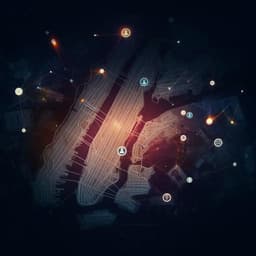
Transportation
High-speed rail new towns and their impacts on urban sustainable development: a spatial analysis based on satellite remote sensing data
S. Zou, X. Fan, et al.
Explore how 223 high-speed rail new towns in China have fostered urban sustainability and reduced development disparities from 2011 to 2021. Shaohui Zou, Xiangbo Fan, Lei Wang, and Yuanzheng Cui's research offers valuable policy insights for China and beyond.
~3 min • Beginner • English
Introduction
China’s extensive high-speed rail (HSR) expansion has reshaped regional accessibility, population mobility, and urbanization. Around HSR stations, a new urban development model—high-speed rail new towns (HSRNTs)—has emerged, intended to integrate transport with high-quality public services and eco-friendly technologies. HSRNTs can optimize urban spatial structure and relieve pressures in old urban areas, but also pose risks of excessive land and resource consumption and uneven development outcomes, especially in inland regions. Policy guidance since 2018 has noted issues of over-scaled planning and weak supporting facilities around stations. The research gap lies in a lack of quantitative, spatially explicit assessment of how HSRNTs affect the coordinated development of urban economy–resource–environment (ERE) systems. This study evaluates how HSRNT construction influences urban sustainable development across Chinese cities from 2011–2021, with attention to differences between central versus peripheral HSRNTs and across regions and city sizes, to inform planning and policy for sustainable urban development.
Literature Review
Prior studies on HSR and station areas largely address transportation accessibility, land and housing price effects, industrial restructuring, and station area development outcomes. Some works assess plan implementation and determinants for HSR station areas, and big-data-based case analyses exist for specific HSRNTs. However, a direct, quantitative evaluation of HSRNTs’ comprehensive impacts on coordinated urban economic, resource, and environmental development is lacking. There is debate over whether HSRNTs drive balanced development or induce hollowing in certain regions. This study seeks to fill that gap by integrating long-term satellite remote sensing with spatial econometric modeling to measure HSRNT impacts on urban sustainability.
Methodology
- Study scope and period: 223 HSR new towns across Chinese prefecture-level cities, 2011–2021.
- Urban sustainable development (USD) index: The economy–resource–environment (ERE) framework draws on indicators from official yearbooks and databases (e.g., China Urban Statistical Yearbook, China Urban Construction Statistical Yearbook, EPS, CSMAR). Indicators span economic size/structure/quality; resource supply/consumption/quality; environmental pollution/governance/quality (see Table 2 in paper). A comprehensive index is constructed (entropy method noted in the research design) to assess coordinated ERE development.
- Remote sensing data: Nighttime lights from a cross-sensor calibrated, continuous NPP-VIIRS-like dataset (2000–2018 extended; ~500 m resolution; nanoW cm−2 sr−1 units), ensuring comparability across time. Built-up area from annual 30 m China land cover dataset (1990–2022; Landsat-based, Wuhan University). Using Google Earth Engine, annual mean and total nighttime lights and built-up area were extracted within a 3-km buffer (≈28.26 km²) around each HSRNT, representing the core development zone.
- Spatial weight matrices: Two matrices constructed: (1) an economic–geographic nested matrix W1 combining distance decay with economic development scaling (per-capita GDP), and (2) a pure geographic inverse-distance matrix W2 using city coordinates from the National Basic Geographic Information Center.
- Models: After LM, LR, and Wald tests confirm spatial dependence and favor the Spatial Durbin Model (SDM) over SAR/SEM, both static and dynamic SDMs are estimated. The dynamic SDM includes lagged dependent variable to capture temporal dependence and mitigate endogeneity: LnUSD_it = α + β1 W(LnUSD_it + LnUSD_it−1 + LnHSRNT_it + LnX_it) + β2 LnUSD_it−1 + β3 LnHSRNT_it + γ LnX_it + μ_i + λ_t + ζ_it. Controls: FDI, total social retail sales to GDP ratio (TRSCG), urbanization rate (URB), digital economy level (DE), and population density (PD), all log-transformed. Fixed-effects panel models are additionally used for heterogeneity analyses by region (east/central/west), HSRNT type (central vs peripheral), and city size (small, medium, large, extra-large).
- Spatial effect decomposition: Following Pace (2009), direct, indirect (spatial spillover), and total effects are computed for short- and long-term impacts when spatial lag terms are significant.
- Data handling: Samples with severe data gaps were excluded; some missing values were interpolated. Variables are logarithmically transformed to address heteroscedasticity.
Key Findings
- Built-up area and nighttime lights growth (2011–2021): Both rose markedly, with nighttime lights growing faster than built-up area. Regional average growth rates: Built-up area—East 39.54%, Central 86.66%, West 82.75%. Nighttime lights—East 148.81%, Central 356.53%, West 275.91%.
- Spatial clustering: HSRNT development and USD indices exhibit significant positive spatial autocorrelation (Moran’s I), with H–H and L–L clusters; clustering strengthens over time. Ignoring spatial dependence would bias estimates.
- Model performance: Dynamic SDM exhibits higher R² than static SDM under both W1 and W2 (e.g., R² up to 0.818 under W2). Lagged USD term is positive and significant, indicating temporal dependence; spatial-rho is positive and significant, confirming spatial spillovers.
- Average impact of HSRNTs on sustainability: LnHSRNT has a significantly positive coefficient (p<0.01). Spatial lag of LnHSRNT is also positive, indicating cross-city influence.
- Effect decomposition (significant at 1%): Short-term effects—Direct 0.031; Indirect 0.054; Total 0.085. Long-term effects—Direct 0.035; Indirect 0.099; Total 0.133. HSRNTs increase local USD and produce strong positive spillovers that are larger in the long run.
- Regional heterogeneity (fixed-effects models): Central-type HSRNTs outperform peripheral-type across all regions. Example coefficients (LnHSRNT): Eastern cities—Peripheral 0.204**; Central 0.319***. Central region—Peripheral 0.152***; Central 0.291***. Western region—Peripheral 0.100 (marginal), Central 0.126*.
- City-size heterogeneity: Central-type HSRNTs have stronger effects than peripheral-type across city sizes, with a hierarchical pattern reported as extra-large > medium-sized > small > large cities.
- Population dynamics: Cities with net population inflow experience stronger positive effects of HSRNTs on ERE coordination than outflow cities. Under large inflows, central-type HSRNTs yield greater ERE coupling/coordinating benefits than peripheral-type.
Discussion
The analysis shows HSR new towns contribute positively to urban sustainable development by enhancing economic vitality, enabling industrial upgrading, optimizing resource use, and improving environmental indicators. Strong positive spatial spillovers mean benefits extend to neighboring cities, particularly over the long term as HSRNTs attract people and resources and subsequently catalyze broader regional development. Impacts vary by region due to differences in industrial bases, human capital, infrastructure, and policy environments—highest in the east, followed by the central, and relatively weaker in the west. Location within the urban structure matters: central-type HSRNTs, embedded near traditional CBDs, exert stronger effects than peripheral ones due to superior accessibility and integration with existing urban systems. These findings support planning strategies that leverage HSRNTs as hubs for coordinated, sustainable regional growth while fostering intercity linkages to diffuse benefits.
Conclusion
The study integrates long-term satellite remote sensing with spatial econometrics to quantify how 223 HSR new towns (2011–2021) affect urban sustainable development across China. Key contributions: (1) Documented significant growth in built-up areas and nighttime lights with diminishing inter-city HSRNT development disparities; (2) Established that HSRNTs significantly enhance urban sustainability with strong positive spatial spillovers—short- and long-term direct and indirect effects are all positive, with larger long-term spillovers; (3) Demonstrated heterogeneity: effects are strongest in economically advanced eastern cities and weakest in western cities, and central-type HSRNTs outperform peripheral-type across regions and city sizes. Policy recommendations include: strengthening intercity transportation connectivity and balanced regional development; promoting intercity cooperation and resource sharing among HSRNTs and neighboring cities; and tailoring planning by region and HSRNT type—prioritizing central-type hubs in the east while bolstering peripheral-type infrastructure in the west—to maximize sustainable outcomes.
Limitations
The study excludes samples with severe data gaps and applies interpolation for some missing data, which may influence robustness. Differences between original nighttime light sensors (DMSP-OLS vs. VIIRS) are addressed through a calibrated, comparable NPP-VIIRS-like long-term dataset, but residual measurement issues cannot be fully ruled out.
Related Publications
Explore these studies to deepen your understanding of the subject.







